The shape or profile of a guitar neck massively impacts how it feels to play. There are four different aspects to consider:
- Profile (shape)
- Depth (thickness)
- Fretboard Width
- Fretboard Radius
In this article I’ll take you through everything you need to know to choose the best guitar neck for you.
Neck Shape
There are 4 main different guitar neck shapes:
- C-Shape
- D-Shape
- U-Shape
- V-Shape
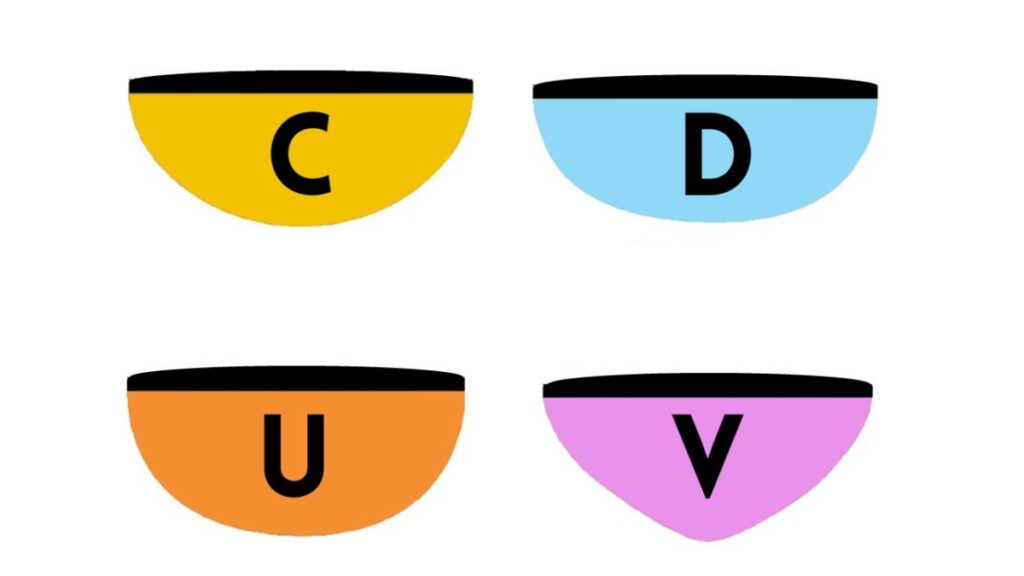
This refers to the shape of the neck if you cut a cross-section of it. It’s important to point out that neck shape, and neck thickness (depth) are not the same thing. For example, you can get thick and thin versions of a C-shape neck. I’ll discuss neck depth in detail later in the article.
Different neck shapes suit different hand positionings. Here is a table to summarise before we go into the more in-depth descriptions of each profile.
| Neck Shape | Characterised By | Suitable For |
| C-Shape | Oval-shaped with curved shoulders | Most hand positions |
| D-Shape | Moderately-high shoulders and flatter mid-section | Most hand positions, especially those who rest their thumb on the back of the neck |
| U-Shape | Very high-shoulders and flat mid-section | Players who anchor their thumb on the back of the neck |
| V-Shape | Pointed mid-section and shallow shoulders | Players who have their thumb over the top of the neck or anchored on the back of the neck |
C-Shape Necks
C-shape necks are also often referred to as oval-shaped necks as they are characterised by an smooth curved shape with rounded shoulders. C-shape necks are the most popular on both electric and acoustic guitars. In fact, out of all Fender’s current range of guitars, over 70% of them have C-shape necks.
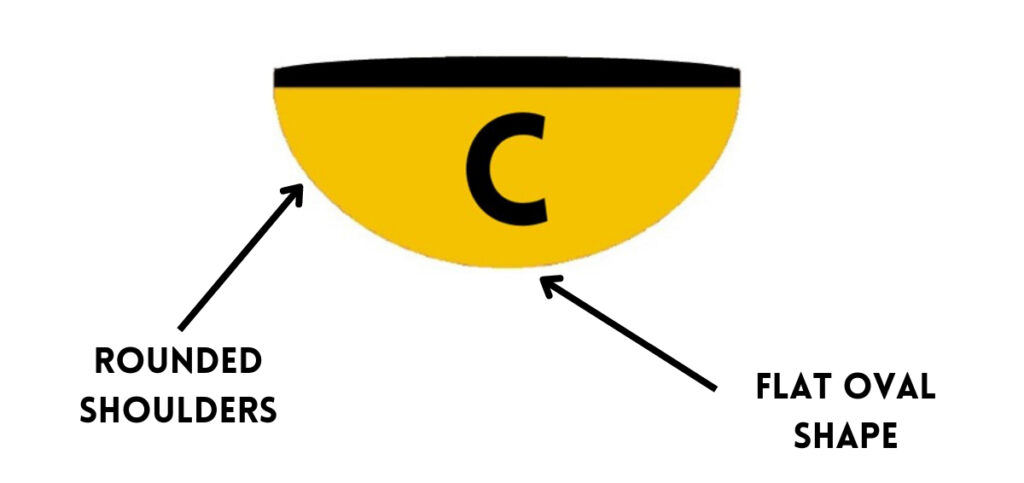
The main reason why C-shape necks are so popular is because they are considered almost universally comfortable. The rounded shape feels comfortable for most players and suits most hand positionings.
There are different versions of the C-shape neck which have different thicknesses. For example, the Fender “Modern C” is slimmer than the Fender “Deep C”, but they both share that C-shape. I’ll discuss neck depth in more detail later in the article.
Suitable For: most hand positionings (e.g. thumb on the back of the neck/ over the top of the fretboard) and hand sizes
Examples:
- Fender’s “Modern C”
- Fender’s “Deep C”
- Gibson’s “Rounded” (found on the Les Paul ’50s Standard)
- Gibson’s “Slim Taper” (found on the Les Paul ’60s Standard)
D-Shape Necks
Most players find D-shape necks to be quite comfortable, although they are typically not as universally comfortable as C-shape necks due to their broader shoulders. Check out my in-depth comparison between D and C-shape necks to learn more.
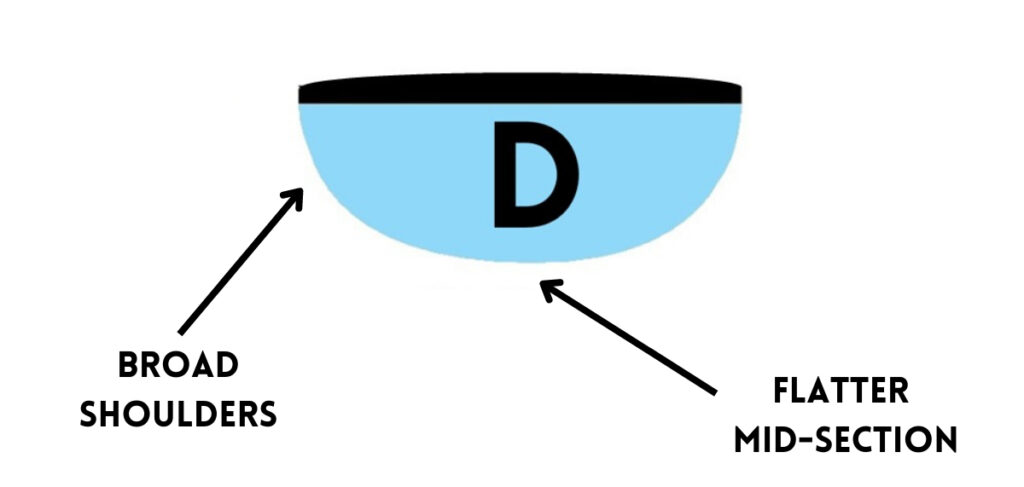
D-shape necks are often preferred by players who like to have their thumb rested on the back of the neck and keep it anchored when playing lead and adopting a more classical hand position.
Again, there are different types of D-shape necks which vary in depth, however on most modern guitars, D-shape necks usually have quite a shallow depth which makes them great for shredding and players with smaller hands.
Suitable For: most hand positionings but especially players who like to rest their thumb on the back of the neck
Examples:
- Fender’s “Modern D” (found on all American Ultra models)
- Fender’s “Augmented D” (found on all American Ultra Luxe models)
- Gibson “Slim Taper D”
U-Shape Necks
U-shape necks have very broad shoulders (broader than D-shape necks) and are flatter across the mid-section compared to the other three neck shapes. U-shape necks are not nearly as popular as C-shape and D-shape necks as they are a lot more polarising.
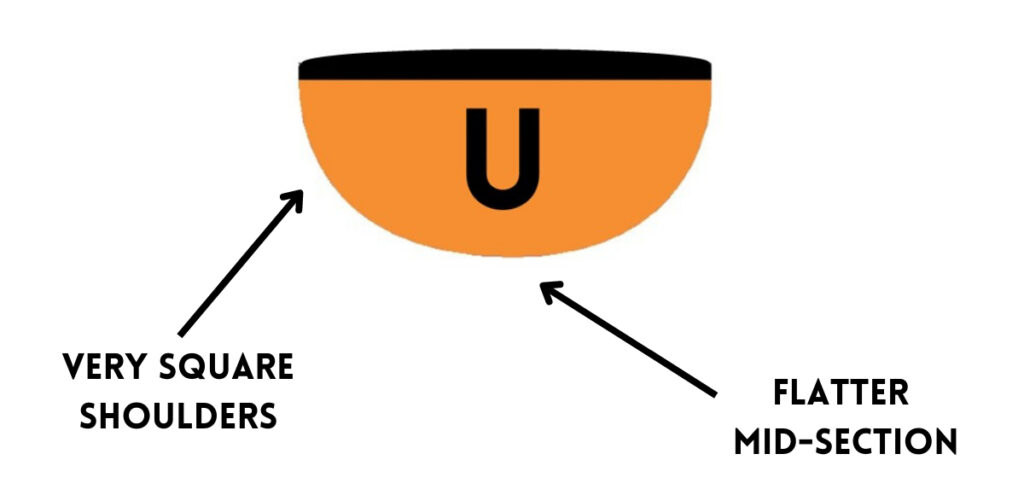
There are two main types of the U-shape neck: the baseball bat, and the shredder’s U-shape.
The baseball bat U-shape neck can be found on a lot of vintage inspired guitars such as the ’50s Telecaster. This neck feels very chunky and typically only suits players who have quite large hands. However, some players prefer the feel of a chunky and sturdy baseball bat neck.
On the flipside, you can get very thin U-shape necks which are ideal for shredding such as the Schecter “Thin U”. The reason that thin U-shape necks are ideal for shredding is because they force the hand into a more classical position with the thumb on the back of the neck. This keeps the hand anchored and is ideal for single note playing.
Suitable For: players who like to anchor their thumb on the back of the neck
Examples:
- Fender’s “1951 U-Shape Neck” (found on the Vintera ’50s and American Vintage II 1951 Tele)
- Schecter’s “Ultra Thin U” (found on the Banshee)
- ESP’s “Thin-U”
V-Shape Necks
V-shape necks are characterised by having very shallow shoulders and a pointed mid-section.
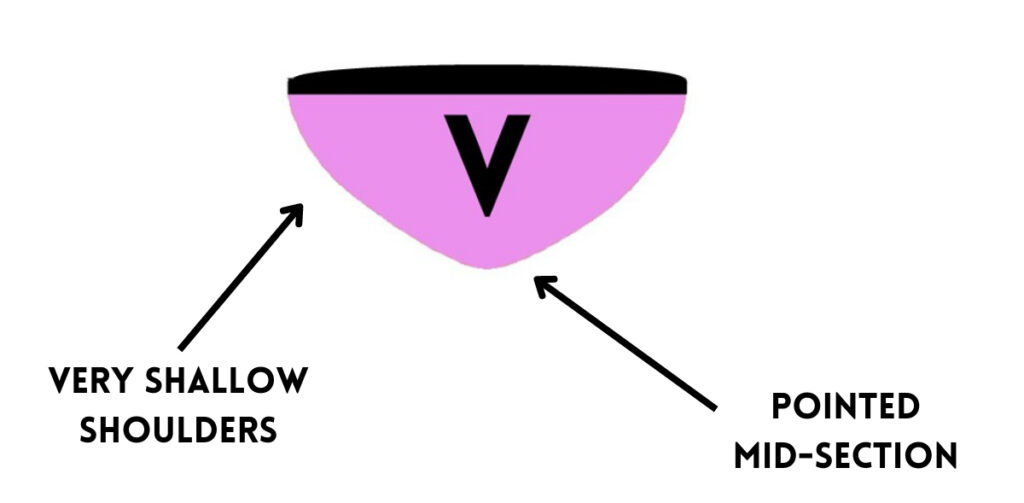
There are two main types of V-shape necks: hard-V and soft-V. Hard-V necks have a more pointed shape in comparison to soft-V necks. Soft-V necks tend to be more popular than hard-V necks as they are a little less polarising and more players find them comfortable.
V-shape necks are not nearly as common as C-shape or D-shape necks because fewer players find them comfortable. However, if you like to rest your thumb over the top of the fretboard and use it to actually fret strings, you’ll find the V-shape neck to be the more suitable shape.
Some players who adopt a more classical hand position with the thumb anchored on the back of the neck also like the feel of a V-shape. Although, this is usually more comfortable with a soft-V rather than a hard-V shape.
Suitable For: players who like to rest their thumb over the top of the fretboard or anchored on the back
Examples:
- Fender’s “Soft-V” (used on the American Original ’50s and Vintera ’50s Stratocasters)
- Gretsch’s “Vintage V” (used on the G9555 New Yorker)
Asymmetric Necks
The final neck shape we need to address is the asymmetric neck. Asymmetrical guitar necks are slimmer on one half and thicker on the other half. Typically, the neck is thinner on the higher pitched strings (G-B-E) and thicker on the lower pitched strings (E-A-D).
The benefit of this shape is that is makes soloing and fast single-note-playing, as this section of the neck is slimmer, but the other half of the neck where you’d play power chords is thicker so the hand is less likely to cramp up.
A good example of the asymmetric neck shape is on the Gibson SG Modern. This is essentially a Slim Taper D-shape neck, but with less depth on the higher pitched strings.
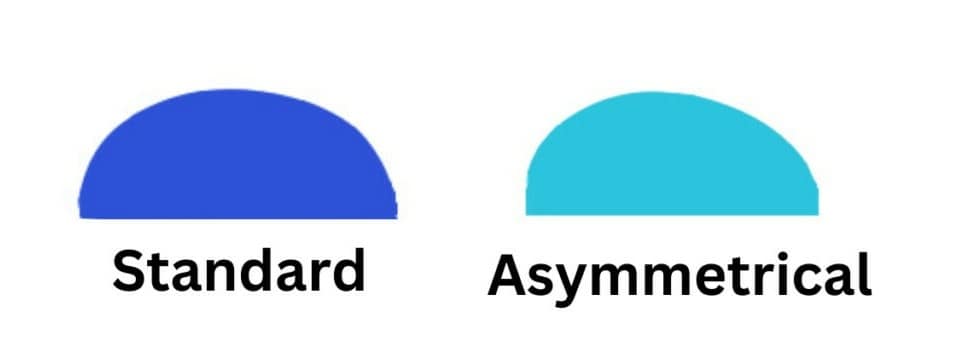

Neck Depth
Now we’ve addressed the different neck shapes, we can move onto neck depth (also referred to as the neck thickness). Neck depth is independent of neck shape, so you can for example get a U-shape neck which is thinner than a C-shape neck. This is why it’s important to consider both variables.
It’s also important to remember that neck depth and neck width are NOT the same thing.
- The depth of the neck refers to how thick the back of the neck is. This is often incorrectly referred o as the width.
- The width of the neck refers to how wide the fretboard is. The most common metric to use here is the nut width.
I’ll discuss neck width in the next section of this article.


Thick vs Thin Necks
- In general, thicker guitar necks suit players with larger hands compared to thinner necks which suit players with smaller hands.
- Thinner necks are often preferred for lead-playing which involves fast single-note lines, whereas thicker necks are often favoured by rhythm players who play a lot of chords.
The reason being, that thinner necks help a lot of players move up and down the fretboard more quickly, This is why a lot of “shredders” necks are ultra thin.
The drawback of a thin neck is that it can cause some people’s hand to cramp up (especially if they have larger hands) when holding barre chords. This is often why thicker necks are selected for rhythm playing, even if the player has a relatively small hand.
I’ve written a whole article comparing thick and thin guitar necks if you’re looking for more information.
Neck Depth Measurements
The depth of the neck varies along the fretboard, and becomes thicker as you get closer to the neck. This is why most brands give the 1st fret and 12th fret thickness to give you a good overall gauge of how deep the neck actually is.
On average, guitar necks are between 0.8-0.9″ thick at the 1st fret and between 0.85-0.95″ thick at the 12th fret. It is possible to find guitar necks which are thicker and thinner than this though.
In the table below you’ll find some examples of popular electric guitar necks and their depth measurements (thicknesses). Keep in mind that there will always be some variation in the measurements from guitar to guitar. For example, two models of the same guitar may have slightly different neck depths (usually by 0.01-0.03″).
| Neck Profile | 1st Fret Depth | 12th Fret Depth |
| Ibanez Super Wizard | 0.67” | 0.75” |
| Schecter Ultra Thin-U | 0.75” | 0.79” |
| Jackson Speed Neck | 0.79” | 0.85” |
| ESP Thin-U | 0.79” | 0.87” |
| Fender Modern D | 0.83” | 0.87” |
| PRS Pattern Thin | 0.83” | 0.89” |
| Fender Modern C | 0.83” | 0.91” |
| Gibson Slim Taper | 0.82” | 0.93” |
| Gibson Rounded | 0.87” | 0.98” |
| PRS Pattern Vintage | 0.875” | 0.98” |
| Fender Soft-V | 0.91” | 1.00” |
| Fender ‘50s U | 0.94” | 1.00” |
Check out this list of electric guitars with the thinnest necks.
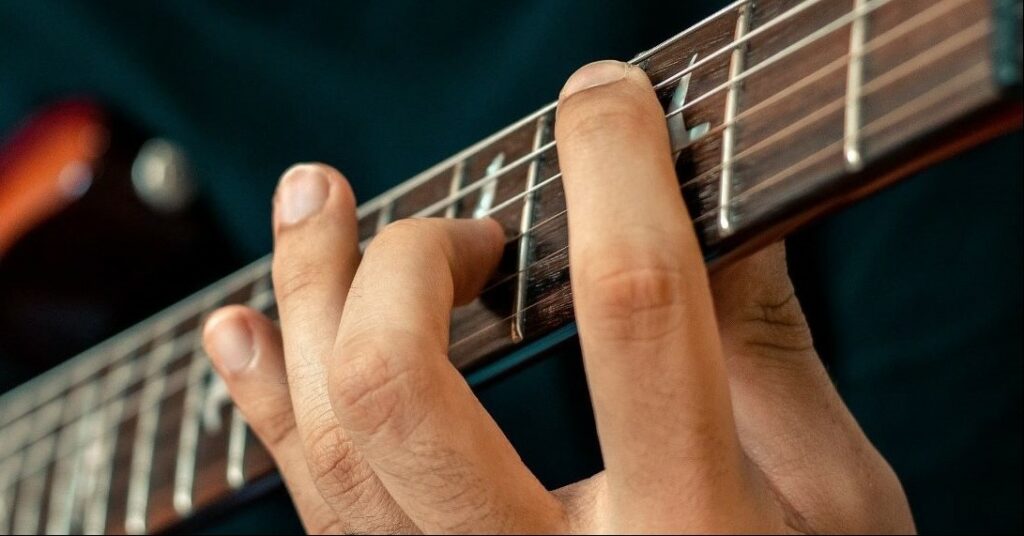
Fretboard Width
Fretboard width, is also often referred to as neck width. The width of the fretboard increases as you get closer to the body of the guitar, but generally, the width of the guitar’s nut is the metric used to gauge the overall width of the neck.
Having a wider fretboard means that the strings are spaced further apart from each other. This can make things a little trickier if you have smaller fingers, but is preferred for styles like shredding, because it makes fretting the wrong string less likely when playing very fast.
Most electric guitars have a nut width between 1.65 and 1.69″. Most acoustic guitars have a nut width between 1.69″ and 1.75″. Here are some tables showing the nut width of popular electric and acoustic guitars.
| Electric Guitar | Nut Width |
| Squier Classic Vibe Models | 1.65” |
| Fender Player Models | 1.65” |
| PRS 509 | 1.66” |
| Fender American Professional II Models | 1.685” |
| Gibson Les Paul/ SG | 1.69” |
| PRS Custom 24 | 1.69” |
| Gibson ES-335 | 1.695” |
| Gibson ES-355 | 1.687” |
| Acoustic Guitar | Nut Width |
| Martin LX1 Little Martin | 1.69” |
| Taylor GS Mini | 1.69” |
| Epiphone J-45 | 1.692” |
| Epiphone Hummingbird | 1.724” |
| Gibson J-45 | 1.724” |
| Gibson Hummingbird | 1.724” |
| Martin D-18 | 1.75” |
| Martin D-28 | 1.75” |
| Taylor 814ce | 1.875” |
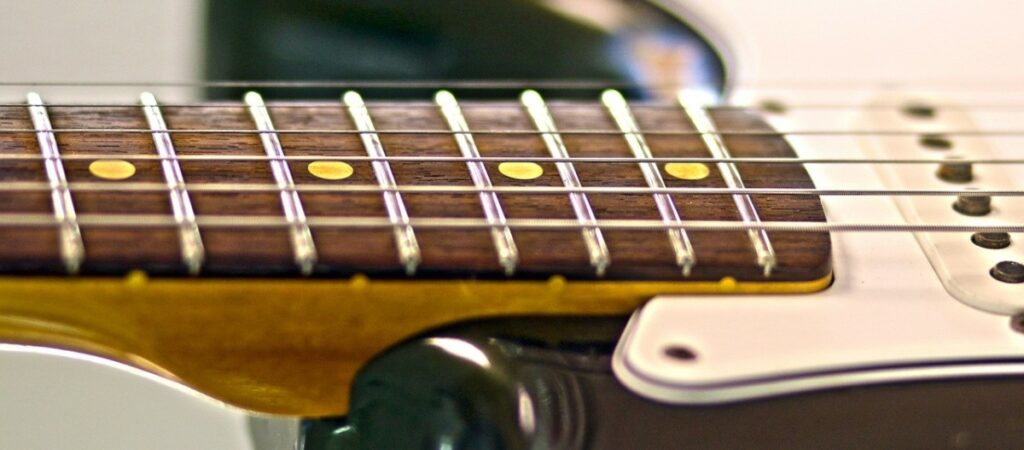
Fingerboard Radius
The final aspect we need to consider is one that is often overlooked, and that is the fingerboard (fretboard) radius.
All fretboards have some degree of curvature. The fingerboard radius is the measurement that indicates how much curvature it has.
- Smaller fingerboard radius = more curved fingerboard
- Larger fingerboard radius = flatter fingerboard
For example, a fretboard with a radius of 9.5″, is more curved than a fretboard with a radius of 12″. Check out the diagram below to demonstrate.

There is no “ideal” fingerboard radius, as like a lot of guitar specifications, it’s purely down to personal preference. However, there are some common opinions:
- Smaller fretboard radiuses feel more comfortable when holding chords
- Larger fretboard radius make string bending and fast playing easier. This is why “shredding” guitars have very large fingerboard radiuses.
Check out my article comparing the two most common radiuses (9.5″ and 12″) to learn more.
Most fingerboards have a radius between 7.25″ and 16″.
- Fretboards with 7.25-9″ radiuses are considered very curved
- Fretboards with 9-12″ radiuses are considered average
- Fretboards with radiuses above 12″ are considered very flat
Here is a table showing the fingerboard radiuses of popular acoustic and electric guitars.
| Electric Guitar | Fingerboard Radius |
| Fender American Vintage/ Vintera | 7.25” |
| PRS SE Silver Sky | 8.5” |
| Fender Player/ American Performer/ American Professional | 9.5” |
| PRS Custom 24 | 10” |
| Gibson Les Paul/ SG | 12” |
| Gibson J-45 | 12″ |
| Fender Player Plus | 12” |
| Taylor 110e | 14″ |
| Ibanez S Series | 16” |
| Martin D-18 | 16″ |
| Ibanez RG Series | 16.9” |
Compound Radius
Some guitar necks actually have what’s called a “compound radius” which means the radius is lower (hence more curved) at the lower frets, and higher (hence flatter) at the upper frets. The advantage here is that playing chords at the lower frets still feels nice and comfortable, whereas soloing at the upper frets also feels easier too.
Examples of guitars with compound radius fingerboards:
- Ibanez AZ2204N (9-12″)
- Fender American Ultra Strat/ Tele (10-14″)
- Gibson SG Modern (10-16″)
- Jackson Soloist (12-16″)
- Schecter Banshee Mach (12-16″)
Frequently Asked Questions
What is the best neck shape for small hands?
Most guitar players with smaller hands will prefer C and D shape necks with narrower fretboards and a shallow width. Necks with a larger fingerboard radius have a flatter fretboard and are often preferred by guitarists with smaller hands and fingers. Examples include the Fender Modern C and Gibson Slim Taper.
Check out my article on the best neck shapes for small hands (with examples).
What is the best neck shape for large hands?
Most guitar players with larger hands will prefer fuller necks, but this can be any shape (C, D, U or V) depending on preference. Examples of larger necks include the Fender ’50s U and Gibson Rounded neck profiles.
What is the best neck shape for shredding?
The best guitar necks for shredding have a large fingerboard radius, C/D/U shape, wide fretboard and shallow depth. Examples include the Ibanez Wizard, Schecter Ultra Thin-U, Jackson Speed Neck and ESP Thin-U.
Check out my article on the best neck shapes for shredding (with examples).
Check out my complete guide to fret sizes e.g. jumbo, medium jumbo, vintage, narrow tall etc.
